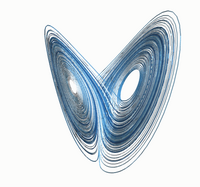Migration Forecast #3
(Updated Fri 15.3.13)
“The results are correct – just don't ask how it can be like that. No-one understands how it can be like that.”
Richard P. Feynman: Quantum Electrodynamics 1990
Edward Lorenz thought
he was going nuts.
For days, he had been
running a program on his LQP-300 computer. The machine was large,
noisy, inconvenient and (by today's standards) desperately slow –
but in June 1962, it was the best that his department at the
Massachusetts Institute of Technology could afford. Because of the
speed problem, he would start the program, let it run overnight, and
study the results next morning. And he was getting nowhere. Slowly.
Lorenz was
investigating the behaviour of something called “hydrostatic
convection flows in a non-Hamiltonian system” and, as a starting
point, had written down some simple equations for this.
The difficulty was:
every time this program ran, it produced a different result!
 As a good scientist,
Lorenz decided that – assuming he was not really going mad –
there must be something peculiar about the way the numbers themselves
worked out. And this was important, because Edward Lorenz wasn't
actually studying mathematical oddities at all – he was trying to
find out why the simulation models used in long-range weather
forecasting kept being wrong. In time, his work (and that of others)
led to a completely new discipline of science: Deterministic
Non-linear Dynamics, more popularly referred to as “Chaos
Theory”...
As a good scientist,
Lorenz decided that – assuming he was not really going mad –
there must be something peculiar about the way the numbers themselves
worked out. And this was important, because Edward Lorenz wasn't
actually studying mathematical oddities at all – he was trying to
find out why the simulation models used in long-range weather
forecasting kept being wrong. In time, his work (and that of others)
led to a completely new discipline of science: Deterministic
Non-linear Dynamics, more popularly referred to as “Chaos
Theory”...
You've heard of this
before. It includes features such as the “butterfly effect” - the
proposition that an immeasurably small difference in the initial
conditions of a system, can result in very large-scale changes in how
that system behaves over time. Almost all climate and weather
mechanisms are non-linear systems but – like the animals in
Orwell's 1984 - some are more non-linear than others. The north
Atlantic jetstream is one such and, around this time of year, it
starts bustin' some seriously sharp dance moves:-
 |
| Click for larger image |
All these loops and
whorls in the jetstream are the signatures of chaotic behaviour.
Most stable oscillating systems have a topological pattern to which
they keep returning: an “attractor.” But the jetstream is NOT
inherently stable. It marks the places where two different masses of
moving air interact with other and the degree of turbulent
interaction changes at every different position, repeatedly switching
from one state to another. When scientists first identified this
phenomenon, they had to invent a new term to describe this class of
weird behaviour in Nature: “Strange Attractors.”
As of this week, we've
seen unseasonably cold weather over much of western Europe: carnage
on the roads in France, and hundreds of flights cancelled at German
airports. And twelve kilometres above our heads, unseen, the
jetstream writhes and dances, until suddenly...
 |
| Click for larger image |
This is the chart of
850Mb isobars and wind direction forecast for next Thursday 21/3. The
blocking anticyclone south of Iceland has vanished and winds will
shift into the south-west, bringing much milder conditions over the
British Isles. Will the strange attractor bring a tide of migrants
home for the new nesting season? It should be so.
Interesting stuff is about to happen...

No comments:
Post a Comment